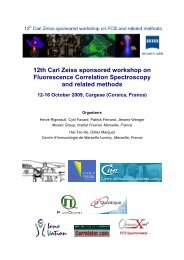My PhD dissertation - Institut Fresnel
My PhD dissertation - Institut Fresnel
My PhD dissertation - Institut Fresnel
Create successful ePaper yourself
Turn your PDF publications into a flip-book with our unique Google optimized e-Paper software.
3.3.6 Relevance of the Data Assessed and Influence of the Steric<br />
Strains on Alkane Cleavage<br />
36<br />
Determination of the relative ease of cleavage for several alkyl substituents was<br />
initially meant to assess their corresponding carbanion stabilities and thus, their related<br />
basicities in solution. Although no accurate reference data are available concerning the<br />
basicities of the species studied herein, the order of cleavage promptness for all the alkyl<br />
substituents perfectly agreed with the experimental reactivity of each corresponding alkyl<br />
carbanions considered. Gas phase acidities of few alkanes have been determined by C.H.<br />
DePuy, R. Damrauer et al. [108] and show a different order for the relative stability of<br />
carbanions:<br />
-C(CH3)3 > -CH3 > -CH(CH3)2, -C2H5 (1)<br />
It is well known that gas phase acidities are dramatically different from those<br />
observed in solution<br />
[ ] 168 . The four effects currently believed to account for these tremendous<br />
variations are the polarization of the carbanions species, the possible resonance and inductive<br />
effects and the hybridization of the carbon bearing the negative charge. In the case of simple<br />
alkanes, the stabilization of the negative charge at the carbanionic center is mainly due to the<br />
[ ]<br />
polarization of the alkyl residue 169 . It is then of evidence that large alkyl anions like tertbutyl<br />
are more efficiently stabilized than smaller ones like methyl group, and thus methane is<br />
less acidic than 2-methylpropane in the gas phase. The stabilization of the same alkyl<br />
carbanions in solution are rather due to solvation, or charge delocalization by mesomeric or<br />
inductive effects. Therefore, the order of relative acidity of given substrates in solution are<br />
usually inversed compared to the gas phase values since steric hindrance usually lowers the<br />
carbanion solvation. For this study, the relative stabilities of alkyl carbanions determined in<br />
solution have been compared to the corresponding gas phase data described in the literature.<br />
According to C.H. DePuy, R. Damrauer et al. [108] , the experimental gas phase acidity order<br />
(1) was unexpected. Furthermore, these authors admitted that the effects of successive αmethyl<br />
substitutions on carbanion stability showed less consistency than that of β-methyl<br />
substitutions, and could hardly be rationalized.<br />
Although well studied in its general features, the exact mechanism still has to be<br />
settled. In this context, the conclusions made from the results collected have to me moderated<br />
due to the fact that steric strains could help favoring one expulsion rather than the other, in the<br />
rate determining step. As a matter of fact, if the concerted mechanism turned out to be the<br />
effective one, two cyclic transition states could be envisaged, as proposed in chapter 3.3.1,













